|
P e r u, B o l i v i a, E x p r e s o d e l S u r
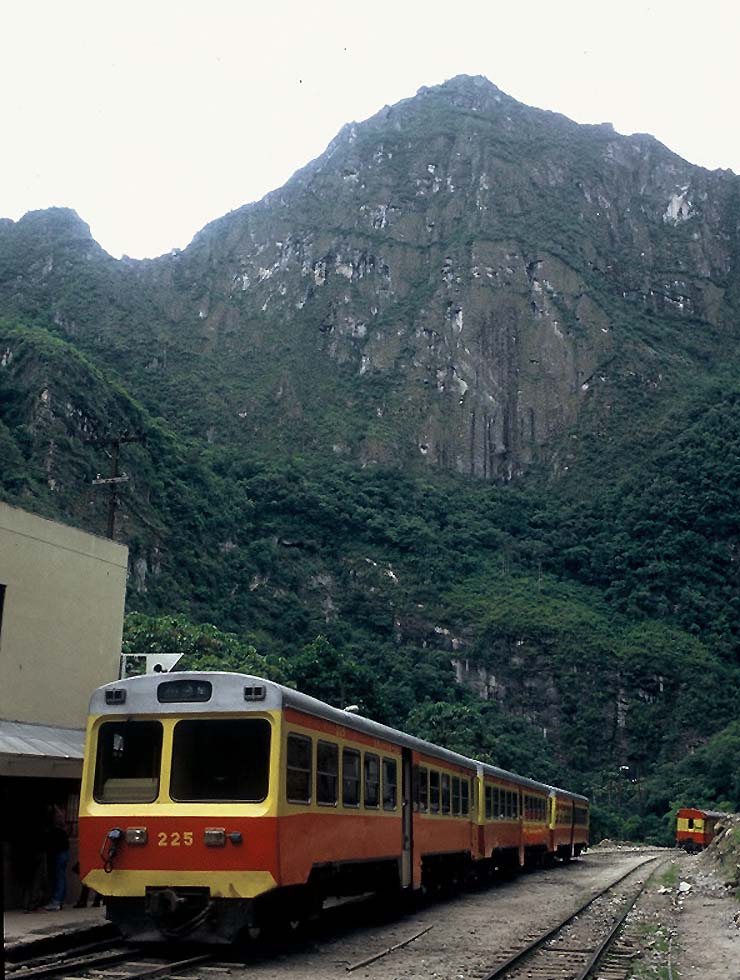 "Tren de Turistas" Cuzco - Machu - Picchu at Puente Ruinas, Feb.1996 (WS)
"Tren de Turistas" Cuzco - Machu - Picchu at Puente Ruinas, Feb.1996 (WS)
Passengers from America or Europe arriving at Callao harbor could take from 1851 a standard gauge steam tramway, later electrified, to the Peruvian capital Lima. It was the first railway in South America. The first mainline in Peru, also standard gauge, was built in the South from Mollendo on the Pacific via Arequipa to Puno on Lake Titicaca, engineered by Henry Meiggs. After war with Chile, Peru was bankrupt and the Peruvian Corporation, founded by the Grace Company, New York, took over all railway activities. Meiggs built the legendary standard gauge Ferrocarril Central for mining purposes from Lima with zigzags over an altitude of 4780 m. It reached La Oroya in 1893, after Meigg's death, and Huancayo in 1908. It got a 3ft gauge extension to Huancavelica, but it never reached Cuzco. That city in the Andes was connected from 1908 by the Ferrocarril del Sur with Lake Titicaca and the existing line to Mollendo.
The ruins of Machu Picchu were discovered in 1911 and from 1920 the 3ft-gauge FC Cuzco-Santa Ana provided services to Puente Ruinas, much later extended to Quillamba. After WWII tourism started and from 1966 a light-blue/silver vista railcar from Ferrostaal and then also orange/yellow Japanese and Spanish railcars were used as "Tren de Turistas". In 1972 state-owned ENAFER had to take over the railways. In the new century James B. Sherwood, owner of the Venice Simplon-Orient-Express, saved passenger traffic by acquiring PeruRail. On the Machu Picchu line the company offered a Deluxe (return fare 588 dollar), as well as a “Vistadome” and a "Backpacker" railcar and for Peruvians standard services. Thomas Cook Overseas Timetable of 2008 described the Deluxe: “A new deluxe train, The Hiram Bingham, has been introduced on the Poroy to Machu Picchu line. It consists of a bar car, two dining cars and a kitchen car which were previously used on the Asian Orient Express.”
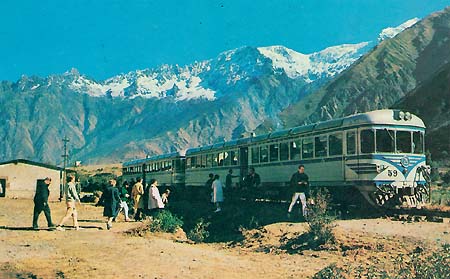
"Tren de Turistas", railcar 59 from Ferrostaal (postcard sent in 1975 by Dr. Fritz Stoeckl)
|
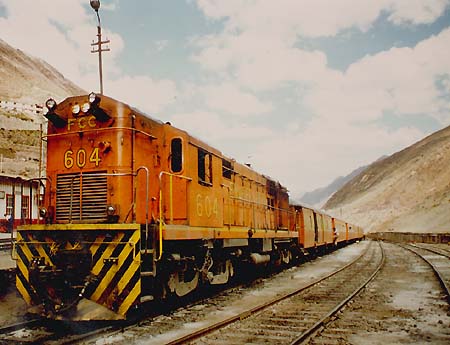
Train Lima - Huancayo on the Central railway, Alco diesel 604 of Enafer in 1980 (Waldemar Gruebl)
|
The Tren de la Sierra Lima - La Oroya - Huancayo and the connecting train to Cerro de Pasco were closed down, but in the new century the timetable listed once again the Tren de la Sierra Lima – Huancayo on certain days and also trains Huancayo - Huancavelica. PeruRail’s blue Andean Explorer ameliorated services from Cuzco to Puno on Lake Titicaca, including diner and an improvised observation car in the rear. Also a train Puno - Arequipa was offered, operating only “for a minimum of 40 passengers”. The Ferrocarril del Sur to Lake Titicaca once has been a way from the Pacific to Bolivia. From 1883 the steamer “Yavari” crossed the lake and in 1929 came the cabin steamer “Ollanta”. At Guaqui connected from 1905 the meter gauge train of the Peruvian Company with La Paz. The steep incline between Bolivia’s capital and the Altoplano was electrified, the other section remained steam-hauled and the few passengers were carried by a small green railcar. From 1981 the “Ollanta” was no longer used for regular passenger services and soon also the Guaqui railway closed down. New hydrofoils connected Puno with Huatajata in Bolivia and now they are used for tourist excursions.
With the War of the Pacific, Bolivia had lost access to the ocean, but a rail link with the Chilean port of Antofagasta became a way to the Pacific. A British company, the Antofagasta (Chili) & Bolivia Railway took over a nitrate railway and extended it in 1892 to Oruro. Even a combined sleeping- and dining-car appeared on that 2 ft 6 in gauge. The Ferrocarril Antofagasta-Bolivia (FCAB) took over operations and in 1928 its whole route was converted to meter gauge. Based on a contract with Argentina of 1925, Bolivia achieved an extension to Villazon, connecting with the meter-gauge Central Norte to Buenos Aires. That FC Atocha-Villazon got in 1929 2-8-2s from Borsig and in 1942 2-10-2s from Baldwin. The connecting FCAB introduced in 1945 small-wheeled Mountain locomotives from Vulcan Foundry. Up to 4 engines were used for lifting a heavy train from La Paz up to the Altiplano! Garratts appeared with freight trains and on the Mulato-Sucre branch line, which reached an altitude of 4787 m. In 1964 Bolivian railways formed the ENFE. The train from Antofagasta still at the end of the ‘80s consisted of wooden FCAB cars, now painted green. It included a diner, but the old sleeping car stood idle in the station. Three diesels hauled the train up to an altitude of more than 4000 m. At the border the passengers had to change to a much newer ENFE train. In the new century the train with the proud title Tren Internacional was confined to the section Calama – Avaroa.
The second railway to the Pacific, a political compensation by the Chilean government, became the Ferrocaril Arica-La Paz, completed in 1917. Wooden meter-gauge Pullman type sleepers and diners from Germany appeared in 1931. Steam locomotives of Esslingen hauled the trains over the rack-and-pinion section. The system was removed when in 1967 General Motors diesels arrived. In 1996 El Internacional to Arica was a “Ferrobus”, a Chilean Swiss-built one should replace it, but then the services disappeared.
El Internacional to Argentina consisted in the ‘70s of wooden cars. When railway historian Bill Pearce tried to take it in 1974, the line near La Paz was blockaded. He caught El Internacional at Oruro and there really was an Argentinian sleeping-car. A travel from Buenos Aires to La Paz in 1977 was described by Hans-Otto Meissner in “Eisenbahn-Safari”: The sleeper of the Estrella del Norte was fully booked for months, but with a tip he got a reservation for a single compartment. However, somebody else got it, too. The car was old, the coaches were crowded and in the diner of 1912 the menu was cooked on a range. The train was steam-hauled from Buenos Aires, at Cordoba it waited for hours, at the border too and in La Paz they arrived 16 hours late, after 4 instead of 3 nights.
Around 1978 a completely new reddish-brown/cream colored diesel-hauled day train from Hitachi with “Pullman”, diner, 1st and 2nd class was introduced between La Paz and Villazon. Still in 1980 in Cook’s timetable appeared also El Panamericano from Tucuman, Argentina, to La Paz with sleeper, diner and coaches. In 1983 El Internacional was seen in Bolivia with the orange colored Hitachi BoBoBo type diesel DE1022 and 8 of the new cars. Between Villazon and La Quiaca passengers had to take a taxi - or to walk across the border. In March 1988 a new Expreso del Sur started - with service by the Wagons-Lits company of France! Three “Pullman” coaches, a diner and a video coach ran from La Paz to the border and one of the Pullmans was to continue to Tucuman, Argentina. During a visit in 1996, the Expreso del Sur was the sensation at La Paz station: a silver-colored streamliner of the ENFE with Argentinian-built cars - paralyzed by strike on account of privatization. Then at least a simple train Oruro-Villazon continued running, consisting of brown/cream cars like also the Tren Inernacional to Calama, no longer to Antofagasta. The 2005 timetable mentioned El Nuevo Expreso del Sur of FCA, including “Pullman” and diner, now only Oruro-Villazon. The connecting meter gauge line in Argentina had been abandoned already in the ‘90s.
Supported by Brazilian and Argentinian policy, beyond the Andes a meter gauge line from Santa Cruz to Corumba in Brazil was completed in 1964 and a link with Argentina’s General Belgrano at Yacuiba followed in 1967. On both lines extra-fare railcars appeared. Projects of connecting that eastern network with La Paz however remained a dream. Trains from Santa Cruz to Yacuiba and an Expreso Oriental to Puerto Suarez continued running, but in Brazil there was no longer a train connection.
Tren de la Sierra
Lima - Huancayo, ENAFER standard gauge, 1974 (according to Dr. Fritz Stoeckl):
2 Diesel (CoCo, MLW), 1 1st class/buffet, 2 2nd class, 1 1st class/buffet, 2 1st class, 3 2nd class (old and new cars, green). Before, 2-8-0 Andes type locomotives hauled the train.
Tren Turistico
Cuzco - Puno, ENAFER standard gauge, Feb. 7, 1996:
Diesel 653 (CoCo, MLW)
1 Equipaje (van)
1 Servicio lnka, no. 1541 (mostly tourist groups)
1 Touristica, no. 1917 (with buffet)
2 Primeira (1st class)
3 Secunda (2nd class)
The van is old-English, the other cars are from Romania.
Colors: Orange/yellow
PeruRail
Refurbished cars, blue/ yellow stripe, on 3ft-gauge Machu Picchu luxury excursion train "Hiram Bingham", also Ferrostaal and other railcars, and Backpacker.
Standard gauge Andean Explorer Cuzco-Puno, including dining car and observation lounge.
El Internacional
Antofagasta - Ollague (-La Paz), FCAB, in 1978 (according to Harald Navé): Diesel 954, 1 van, 5 coaches, 2 1st-class, 1 diner, 1 sleeper (wooden cars, green).
El Internacional
La Paz - Rio Mulato - Villazon, connecting with El Panamericano in Argentina, ENFE meter gauge, in 1975: Steam engine 664 (2-8-2 Hitachi), 10 freight wagons, 1 van, 3 coaches, 1 sleeper (wooden cars, green).
Expreso del Sur
La Paz - Villazon, ENFE meter gauge, Feb. 1996 (paralyzed by strike):
| Diesel (BoBo, Hitachi) | |
| 1352 | Pullman | (coach/guard) |
| 1569 | Pullman | (coach) |
| 1538 | Pullman | (coach) |
| 1556 | Pullman | (coach) |
| 1746 | Comedor | (restaurant) |
| 1571 | Salon | |
Colors: silver with light blue/red, locomotive green/cream
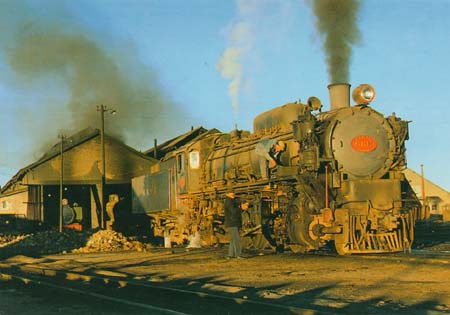
Mikado no.668 of Ferrocarriles Estatales, Uyuni, Bolivia, 1977 (Guenter Haslbeck)
|
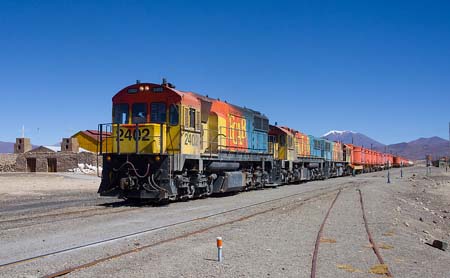
F.C.Antofagasta & Bolivia, engines GR12UM at Ollague, 2012 (David Gubler, www.bahnbilder.ch, via Wikimedia)
|
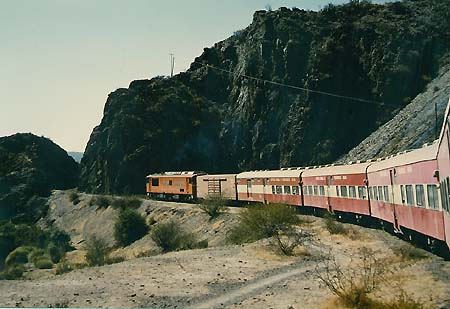
Passenger train La Paz - Villazon, Hitachi diesel, between Tupiza and Villazon, August 1982 (Guenter Haslbeck)
|
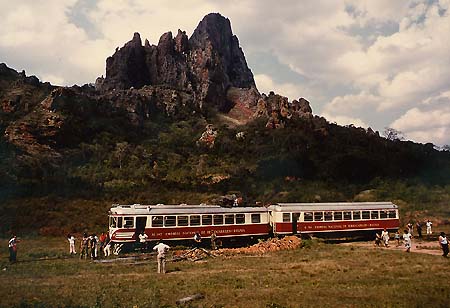
Ferrobus Puerto Suarez - Santa Cruz, August 1982 (Guenter Haslbeck)
|
|